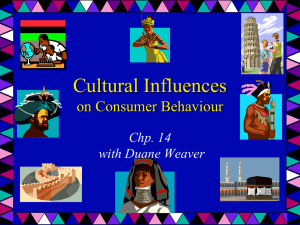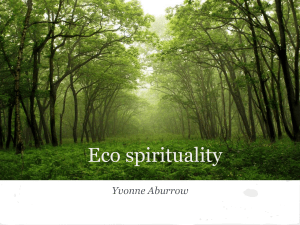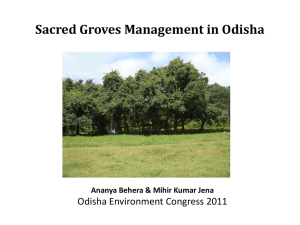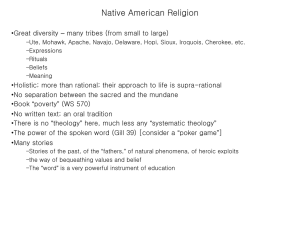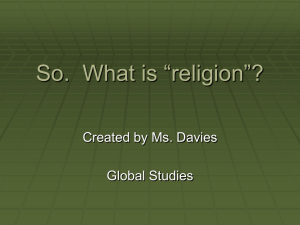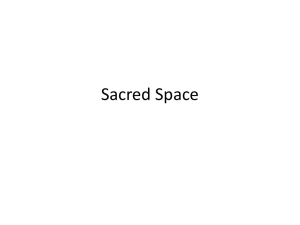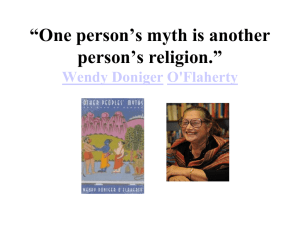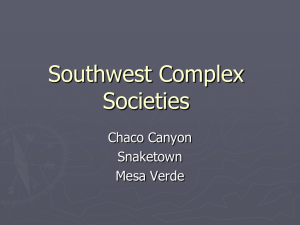PEOPLING OF THE AMERICAS
advertisement
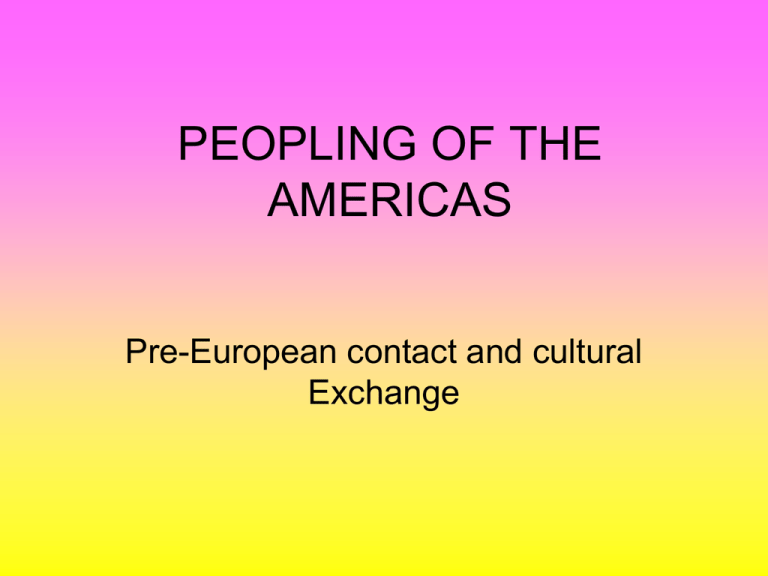
PEOPLING OF THE AMERICAS Pre-European contact and cultural Exchange Focus Questions • What are several theories of where the indigenous peoples of America’s originated and what questions does the evidence raise? • What Civilizations existed prior to European Contact and how have they contributed to American economy, diet and culture? Identification & Study Guide • • • • • Bering Strait Clovis First Monte Verde Pleistocene man Pre Columbian contact • Olmec • Hohokam • Mogollon • • • • • • Anasazi Mississippian Aztec Pope revolt Apalachee Transoceanic Contact Bering Strait Theory • small group of big game hunters in Siberia followed the Pleistocene mega fauna— mammoth, mastodon, and extinct bison • land bridge that formed during the last Ice Age known as Beringia • 12,000 – 20,000 years ago Clovis • 11,500-year-old fluted projectile points found in Clovis, New Mexico. • "Clovis" culture. Monte Verde, Chile • Monte Verde – Southern Chile – Pre-dates Clovis by 1,000 years • How did people reach South America with no traces in between? – Suggests alternate theory Pleistocene Man – San Diego • Yuha Pinto Wash • Dated 50,000 years old • Pre-dates Clovis & Beringia theory Yuha Pinto Wash overlying sediments are dated at more than 50,000 years old Pre-Columbian Trans-Oceanic Contact • 50,000 years ago people migrated by boat to Australia • DNA retrieved from a 10,000-year-old fossilized tooth from an Alaskan island, with specific coastal • • • • Tierra del Fuego Ecuador Mexico California – lends substantial credence to a migration theory that at least one set of early peoples moved south along the west coast of the Americas in boats. Rainbow Bridge Theory • Luzia Skeleton, Lagoa Santa, Brazil – Austro-Malaysian & African origin not Siberian – Pleistocene (8,400 years old) • Columbian River – Oral Tradition • Nazca, Peru – Hawaiian contact – 1,000 years before Columbus • Chumash – Hawaiian Contact – – – – – Pre-European contact 500-700AD (2,500 years old+-) Polynesian Sweet potatoes – origin S. America Tomolo’o Carbon date 600 AD Technology Transfer Oral Tradition Muslim/African voyages • Olmec Heads in Meso-America • 1178 – Chinese Sung Document records voyages of Muslims sailors • 1310 Abu Bakari, Muslim King of Malian empire – voyages to Americas • 1312 Mandiga – Gulf of Mexico to Mississippi River • 1513 Pri Ries completes first world map includes America • 1530 10 million slaves to Americas/30% Muslim Olmec Civilization 1500 BCE – 100 BCE Cocaine Mummies • 21st Dynasty of the Pharaoh’s 3,000 years ago – Henet Tui – Lady of 2 Lands – Dr. Svetla Balabanova, Toxicologist, Munich, Germany • 1992 remains included cocaine & nicotine • 1/3 of other 134 other mummies 3700 BC -1100AD – Additional Testing, Sample of 3,000 remains • • • • • 89% positive Egypt 90% positive Sudan 62.5% Positive China 34% positive Germany 100% positive Austria China 1421 • Chinese reached America 71 years before Columbus? • Chinese Admiral Zheng He – 30 year command of Ming Fleet Civilizations of the Americas • Some Civilizations of the Americas – Northwestern – Southwestern • Anasazi, Mogollon, Hohokam, Sinagua, Salado – South East and Mid west • Mississippian and Mound building civilizations – Meso- America T • Toltec, Olmec, Mayan & Aztec – South America – • Wari, Mochi, Paracas, Nazca, Inca 25 ©2004 Wadsworth, a division of Thomson Learning, Inc. Thomson Learning™ is a trademark used herein under license. South West Civilizations • • • • • Hohokam Mogollon “Anasazi” or ancient puebloan peoples Sinagua Salado Hohokam • First Southwestern Culture to Irrigate crops – >300 miles of Hohokam canals in the Salt River valley alone • Corn, beans, barley, cotton, tobacco, squash, agave • Southern and Central Arizona – Pit houses in earlier periods – Walled villages with multi story above ground adobe buildings Hohokam 300 BCE- 1200 CE Hohokam Invented the first etching process Mogollon • Descendants of earlier Cochise culture (6000 BCE) • Mogollon Culture 300 -200 BCE – “Hunter Gatherer” & some agriculture – Deer, bison, pronghorn, rabbit, turkey, mountain sheep – Beans, squash, corn – Walnuts, cactus, acorns, pinon, agave, mustard, sunflower, wild tomato Mogollon • Small villages • Pithouse construction • Later surface pueblo using stone masonry construction, 4 – 5 rooms to 500 rooms such as the Grasshopper pueblo in the white mountains of AZ. • Last pueblo occupied until about 1400 CE near Springville, AZ. Anasazi • Colorado Plateau • 1CE • Corn, squash, beans • Agave, walnuts, pinon, acorns, yucca, prickly pear, Indian rice grass, wild potatoes Mesa Verde • Elk, deer, pronghorn, • Mt sheep, rabbit, turkey, birds, fish PUEBLO BONITA, NM • A.D. 1030 and 1079 • Constructed the first Apartment Bldg until New York in 1882 Mississippian Culture • Hopewell 100 BCE – 600 CE • Mississippians descendents • Urban & Agricultural centers – Same population as London did in 1200 Cahokia Creek near Collinsville, Illinois, At its height, around A.D. 1200 North Eastern Woodlands • • • • • • Indian democratic tradition Suffrage for women Chief or leaders were servants of the people Diversity respected First government to recognize the existence of a state within a state First governing body: League of 5 nations or the Iroquois before 1600 – Oral constitution – 50 representatives on a council – Onandaga, Seneca, Cayuga, Oneida, Mohawk, and 100 years later the Tuscarora – Clan mother selected chiefs – Women owned crops, houses and had voting rights – Smaller yet the dominant nation in the region Agricultural Influence Today • 40 plants domesticated that make a significant portion of agriculture today • 42% by weight: corn, potato, peanuts • 48% of the money generated from the sale of agricultural products The Peoples California Terms from Lecture • • • • • • • The sacred Clowns Status of old aged Death’s place Interdependence Bird Songs Hygiene Who are “Indians”? • The People • First Nations • Rich Diversity of cultural expressions and languages • Some beliefs & life ways held in common among most Belief systems & Life ways • Shared Concepts – – – – – – – – – The sacred as a practical system of knowledge Respect 7 shared concepts of the sacred way Status of old age History and knowledge transmission Death’s place in the cycle/concept of the circle Hygiene/epidemiological Subsistence Identity The Sacred Explanation of sources of life and ways of knowledge Concept used to explain ways of life, beliefs, traditions & observances Practical System of Knowledge Western views/ indoctrinated religions Attempt to dominate and control unknown To overcome human frailty & weakness Has begun to destroy equilibrium among people and ecosystems The Sacred Limits amount of explaining Guides behavior toward natural laws If you seek to leave nothing unexplored, you will bring disaster – Trying to be like gods rather than humans Seeking Life o Acknowledged the sacred and maintaining a constant relationship between sacred and oneself o Cooperation, sharing and taking no more than needed, giving thanks, equilibrium o Capitalism o “making a living” o Competition o Without balance, without sacred acknowledged Respect For those who protect the sacred ways and help them grow Spiritual life – most important expression of humanity vs. material wealth Sacred never indoctrinated, sectarian or evangelical Simple way of seeking life – Respects all other’s expressions and life ways Individually and communally Shared concept of The Sacred Way 1. 2. 3. 4. 5. 6. 7. 8. The Great Mystery Interdependence Commitment to the sources of life Morals & Ethics Sacred Practitioners Humor is integral to the sacred ways Status of Old Age Learning/history & knowledge Transmission 9. Death’s Place in Life cycle – concept of the Circle The Great Mystery A belief in or knowledge of unseen powers or what some people call the Great Mystery or Great Spirit Deities or spirits A “Feeling” that something exists that is sacred & mysterious Unseen powers Pit River People of N. California A continuous “religious” or sacred experience Interdependence of Life Life depends on understanding and respecting all life and equilibrium that is struck between relationships of all things If you destroy or alter one relationship, all others will be affected and ultimately destroyed also Natural resources are not infinite Modoc People of N. California Dominate western ideology Man’s control of natural world Progress = exploitation of natural resources indefinitely w/ help of science and technology All mysteries, uncertainties, and unknowns can ultimately be Conquered and Explained Worship: personal commitment to sources of Life o Reinforced the bond between the individual, community and Great Powers o Seeking life o community matter o intensely personal one o Ritual & prayer – to better understand the forces of order, disorder, growth and change Forms of Worship • Rituals: to revitalize and put in order the elements in a tribes cosmology – Important times of the year • Summer & winter Equinox/Spring & fall solstice: Make people conscious of economic and social responsibilities connected with planting, harvesting and distributing food – Significant changes • Birth, naming, renaming, puberty, tattoo: Awareness of contribution to the life of the people Forms of Worship • Prayer : directed toward something, the force of individuals will (or groups) • Song: composed for dances, healing, hunting ,honoring, cradle songs – When sung with an objective in mind, they are powerful – Magic words, shadow words Morals & Ethics Morals set the limits and boundaries of personal behavior Ethics teach social behavior Behavior – necessary for survival Responsibility for self and community Accountability for one’s actions and to community Instruction vs. Sin/Hell Figures taught to instruct or coerce children into behaving certain ways Clowns – unselfishness, awareness, patience, cleanliness Sacred Practitioners Responsible for passing sacred knowledge from generation to generation Often gifts are hereditary A person may show inclinations at any time in life Different titles in different communities Heal through prayer, faith, medicinal knowledge of plants and minerals Humor • Necessary part of the sacred • Humans are weak, not gods, weaknesses lead to foolish acts • Too much power & seriousness leads to imbalance • Cannot take ourselves too seriously • Clowns needed to show us how we act and why Status of Old Aged Status of honor and respect Lived long, favored Privileges Asked for names and blessings Give advice Lecture Counsel Right to make opinions known Instruction vs. Command & Corporal punishment Knowledge Transmission • Methods of learning – Initiations, survival training, listening, waiting, remembering • Modes of Learning – Stories, legends & Myths • Methods of recording & passing knowledge – Oral histories, Rock paintings and picto/petrographs, Basketry, other art forms Origin Stories What is transmitted: Where the people came from How stars were created and light became divided by darkness Discovery of fire Origination of death Basic survival tools “coding” abstract notions of behavior, cosmology, ways of seeking knowledge Discover meaning of things or ideas on your own, not indoctrinated or imposed Death’s place • Philosophy of life: never ending path or road – circular thinking – Conveys eternal return – Death in some way returns to the beginning of life – You know all when you are born and slowly forget – Not to be feared, another transition in life • Death ceremonies Hygiene • Cleanliness synonymous with good health and living – Daily bathing and sweating – Knowledge of soap roots and purifying plants – Population controlled – understood limits of the land – Medical people successful and Respected • 18th century Europe – Suffered disease as result of poor hygiene – Overcrowding and malnutrition – Medical doctors unsuccessful and detested by population Subsistence • Acorns/Pinon/Mesquite Beans: Major Staples of first nations Diet • Oak/pine/Mesquite Trees • Can be Made into Flour or Meal by Pulverizing after Leaching (acorn) or Washing • Stored for Winter or Later Use Subsistence • Winter house/Summer house • Managed the landscape • Intimate knowledge of all resources and when and where can be found • Land use songs – Bird/Salt/Deer Songs – – – – Songs hereditary or gifted Rights to use land, shared with permission Resources generally shared and distributed evenly Absence of malnutrition or starvation • western concept of ownership – Paper, legal, private ownership Diversity • California’s Diverse Landscape and Isolation Has Produced Diverse: – Groups – Languages – Subsistence Practices – Modes of Dress and Shelter – Expression of Cosmologies



